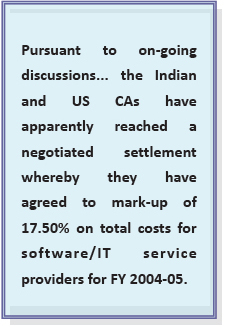|
||||||||||||||||
| Indian & US Competent Authorities reach a negotiated settlement for transfer pricing disputes under the Mutual Agreement Procedure | ||||||||||||||||
|
||||||||||||||||
| Further, on conclusion of MAP the tax payers have an
option whether to accept the decision of the CAs or
not and in the latter case they can follow the normal
appellate procedure in India.
Facts and Settlement During the course of TP audits for financial year 2004‐05 (year ending 31st March 2005), a number of Indian affiliates of US MNCs, which were engaged in providing various software, IT and BPO services were subject to adverse TP adjustments. The Indian tax authorities, adopting a different approach/criteria for accepting/rejecting comparable companies, determined arm’s length transfer price of such service providers at a mark‐up of 25‐30 per cent on total costs, as against 10‐15 per cent on total costs determined/declared by the tax payers.
Pursuant to on‐going discussions, as per media reports, the Indian and US CA have apparently reached a negotiated settlement whereby they have agreed to mark‐up of 17.50 per cent on total costs for software/IT service providers for FY 2004‐05. The settlement provides relief of around 10‐12 per cent for those tax payers who have made applications under MAP. It could also provide correlative adjustment/corresponding deduction at the US end thereby eliminating double taxation. At the same time, the difference between 17.50 per cent mark‐up and mark‐up declared by the tax payer would continue to be liable to tax in India and will not be exempt under any tax holiday provisions in India. Conclusion and Comments The above information is based on secondary sources including media reports and there is no confirmation from the CA of either country . Also, the formal MAP order is not in public domain as yet. The factors and principles that were considered by the CA are also not known currently. While, the above settlement provides relief to tax payers who have invoked MAP, it must be noted that it is applicable only for the tax payers who have made an application under MAP and that too only for the year under consideration and would not apply to any other year(s). Further, it would be applicable only to the specific tax payer and may not carry persuasive value as the detailed facts and basis are not available in the public domain. However, this would be a useful reference pointer to the approach of Indian tax authorities and CA on similar matters in future. More importantly, this MAP settlement may provide a precursor of detailed safe harbor rules which are due to be announced shortly. The above settlement may also provide a sense of succor to the Indian transfer pricing authorities at the field level as they have recently faced a series of setbacks in terms of reversal of their orders by the appellate authorities. In some cases, the appellate tribunal has upheld a mark‐up of 10‐12 per cent for software/IT service providers while rejecting the add‐hoc approach of the transfer pricing authorities. Such tribunal orders would, in turn, encourage the tax payers who had made applications under MAP not to accept the MAP settlement and litigate under the domestic appellate procedure. However, tax payers following a lower mark‐up and who are averse to litigation may wish to revisit their transfer pricing policies and strategies in the light of the above MAP settlement. |
||||||||||||||||
|
||||||||||||||||


 Some of the US MNCs invoked MAP
under Article 27 of the India‐US tax
treaty. These MAP applications have
resulted in discussions and
consultations between CAs of India
and USA to reach a settlement on
the above issue.
Some of the US MNCs invoked MAP
under Article 27 of the India‐US tax
treaty. These MAP applications have
resulted in discussions and
consultations between CAs of India
and USA to reach a settlement on
the above issue.